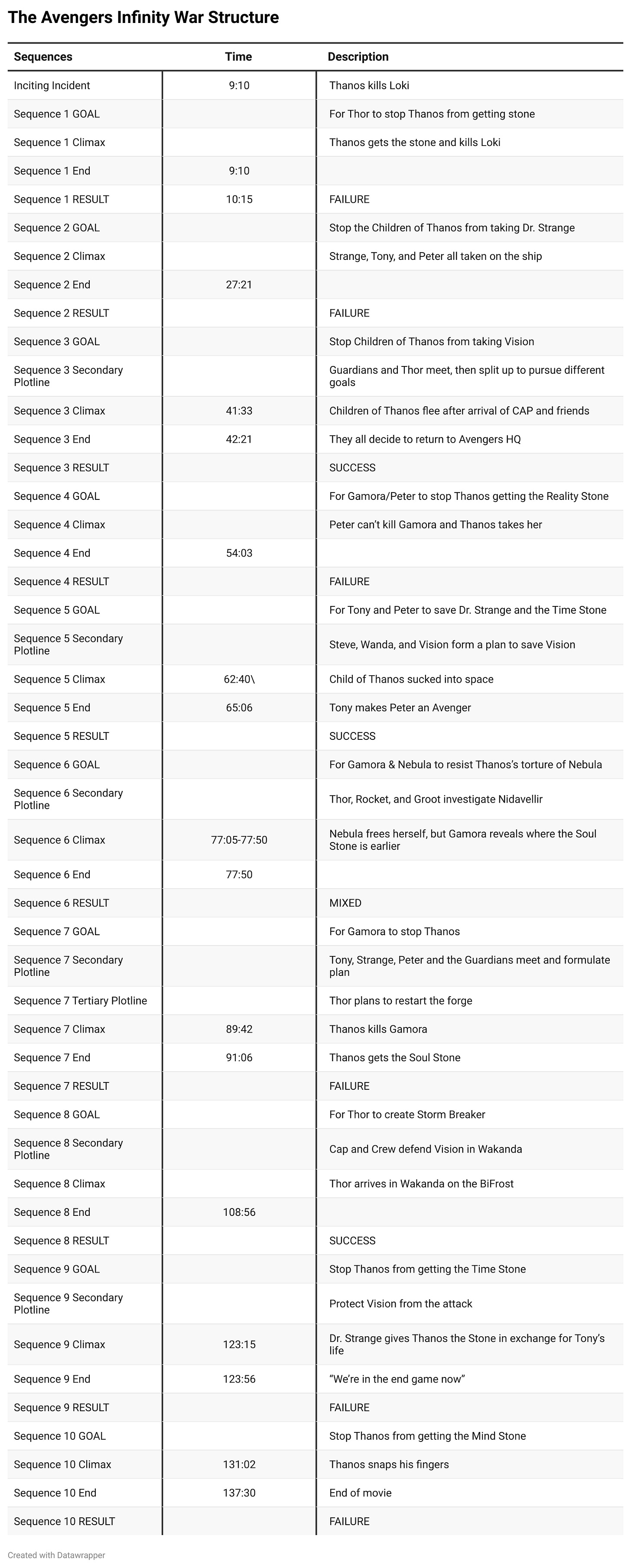The Avengers: Infinity War Structure Breakdown
The Intro
Once again, I partnered with Podcast 241, this time for an analysis of Avengers: Infinity War. So checkout the two-part podcast and read my breakdown below.
Part1
Part 2
As always, these breakdowns contain SPOILERS, and are only recommended if you've already seen the movie. You can check my introduction to these breakdowns, to get an overview of my process and philosophy.
Feel free to let me know what you think in the comments below!
The Basics
Director: Anthony Russo and Joe Russo
Writers:Christopher Markus (screenplay), Stephen McFeely (screenplay), Stan Lee (based on the Marvel comics by)
Release Date: 2018
Runtime: 149 minutes
Movie Level Goals
Protagonist: The Avengers
Antagonist: Thanos
External Goal: To stop Thanos from getting all the Infinity Stones
SUCCESS | FAILURE
Internal Goal: None
Three Observations
Observation #1: Secondary Plotlines
Infinity War is obviously a big movie. There are a couple of dozen characters and many plotlines. Normally sequence structure is built around self-contained units, where we track a single protagonist and don't often leave that character in the middle of a sequence (or if we do, the departure is brief). But Infinity War is unique in that many of the sequences are split across at least two plotlines. This complicates how we approach the driving goal for each sequence. For most of the sequences that move between more than one plotline, I've defined the sequence goal by the plotline that ends the sequence. The plotline that starts the sequence often does not contain a self-contained sequence goal; instead characters establish a goal, or set it in motion, and then continue across multiple sequences. Plotlines that end the sequence generally end on a climax defined by a more clear and specific goal. For example, Sequence 3 starts with Thor meeting the Guardians of the Galaxy. But while they establish goals, they don't finish them in that sequence. In the first few minutes of that sequence they get to know each other. Afterwards, Thor, Rocket, and Groot head to Nedavillir, while Gamora, Peter, and Drax head to Knowhere to try to get the Reality Stone. You could argue that their goal is "to get to know one another" or "make a plan." But contrast this with the sequence's other plotline. The Children of Thanos arrive and try to take Vision. Wanda and Vision are joined by Steve and friends, and they have the strong, clear goal of stopping the Children and protecting Vision. They succeed and the Children are driven off. Sequence 5 has a similar structure, this time with Steve, Wanda, and Vision opening the sequence with the secondary plotline goal of forming a plan to save Vision. Then the sequence cuts to the stronger goal of Tony and Peter trying to save Dr. Strange and protecting the Time Stone. They succeed in a strong climax, which sees another of the Children of Thanos sucked into space, and Tony dubbing Peter an Avenger.
Observation #2: Thanos the Protagonist
Thanks to my friend Dan Wingfield at 241 Studios for pointing this out. While we can analyze almost any movie from the perspective of the antagonist, Infinity War really lends itself to thinking about Thanos as the protagonist (not as the “good” guy, but simply as the character who structures the movie). He definitely drives the movie, with The Avengers constantly reacting to his goals. His movie level goal is to get all the stones and wipe out half the living things in the universe. Once he succeeds, the movie is over. If you look at the sequence level goals, you can see that most of them can be re-stated from the perspective of Thanos. An argument against Thanos as protagonist is that there are some sequences where his goals don’t feature, including those focused on the Children of Thanos. Nevertheless, looking at the move from this perspective is enlightning.
Observation #3: Poor Thor
Infinity War starts with Thor, and so it feels like he will have a major part to play. But after a very entertaining run in with the Guardians of the Galaxy in Sequence #3, Thor gets relegated to spending the rest of the movie getting a new hammer, Stormbreaker. While he’s doing so, Thanos and his children get four of the five remaining stones. Once he finally creates Stormbreaker, he travels to Wakanda and leads the battle against Thanos’s army. Unfortunately, while he’s there, Tony, Peter, and Dr. Strange try and fail to defeat Thanos (why didn’t he just go to Titan?). And furthermore, once The Children of Thanos are killed (a little before the 2-hour mark), Thanos travels from Titan to Wakanda, Wanda kills Vision to destroy the Mind Stone, and Thanos rewinds time and gets the Mind Stone. AND THEN, finally, Thor shows up to try to stop Thanos (almost 10 minutes after the death of the Children of Thanos). Where has he been this whole time? There is no good answer, and this definitely feels like a plot hole. At the same though, there is one compelling answer to why he's sidelined for so long—he's too powerful. Though he was defeated in Sequence #1, his presence at any of the future encounters would have made them significantly easier. He would have defeated the Children of Thanos much more easily, and the encounters with Thanos would have been much more challenging for Thanos. Additionally, his presence would have diminished the plotline between Thanos and Gamora, which provides significant emotional resonance to the movie. And, of course, if Thor had been on Titan, his powers combined with the others would clearly have tipped the balance and enabled The Avengers to protect the Time Stone and strip Thanos of the gauntlet.



